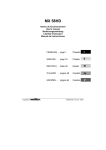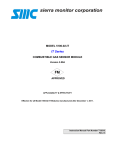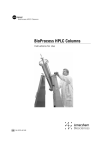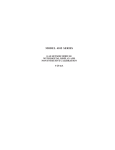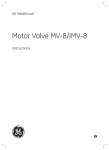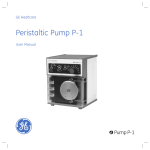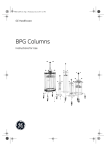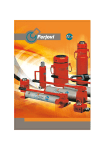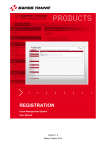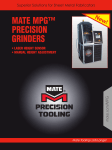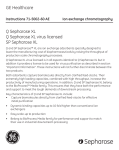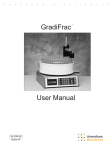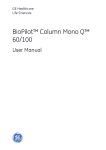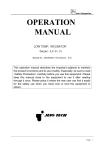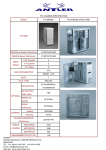Download 4 - GE Healthcare Life Sciences
Transcript
user manual BioProcess Stainless Steel Columns BioProcess Stainless Steel Columns Instructions for Use um 56-1616-98 AA Important user information All users must read this entire manual to fully understand the safe use of the BioProcess Stainless Steel (BPSS) columns. CE Certification This product meets all requirements of applicable CE directives. A copy of the corresponding declaration of conformity is available on request. The CE symbol and corresponding declaration of conformity is valid for the instrument when it is: - used as a stand-alone unit, or - connected to other CE-marked Amersham Biosciences instruments, or - connected to other products recommended or described in this manual, and - used in the same state as it was delivered from Amersham Biosciences, except for alterations described in this manual. Terms and Conditions of Sale All goods and services are sold subject to the terms and conditions of sale of the company, unless otherwise agreed to in writing, within the Amersham Biosciences group that supplies them. A copy of these terms and conditions is available on request. Should you have any comments on this product, we will be pleased to receive them at: Amersham Biosciences AB SE-751 84 Uppsala Sweden Trademarks BioProcess, Sepharose, Sephacryl, Sephadex, and Drop Design are trademarks of Amersham Biosciences Limited. Amersham and Amersham Biosciences are trademarks of Amersham plc. Office Addresses Amersham Biosciences AB SE-751 84 Uppsala Sweden Amersham Biosciences UK Limited Amersham Place Little Chalfont Buckinghamshire England HP7 9NA Amersham Biosciences Corp 800 Centennial Avenue PO Box 1327 Piscataway NJ 08855 USA Amersham Biosciences Europe GmbH Munzinger Strasse 9 D-79111 Freiburg Germany Amersham Biosciences K.K. Sanken Building 3-25-1 Hyakunincho, Shinjuku-ku Tokyo 169-0073 Japan Amersham Biosciences China Limited 13/F., Tower I Ever Gain Plaza 88 Container Port Road Kwai Chung, New Territories Hong Kong © Copyright Amersham Biosciences AB - 2002 All rights reserved Safety Notices This Instructions for Use contains safety notices prompting you on correct use of the column to avoid personal injury and/or damage of the equipment, or to present information that can optimize your use of the columns. The various types of safety notice include: Warning notices WARNING! The Warning notice highlights instructions that must be strictly followed in order to avoid personal injury. Do not proceed until the instructions are clearly understood and all stated conditions are met. Caution notices CAUTION! The Caution notice highlights instructions or conditions that must be followed to avoid damage to the product or to other equipment. Do not proceed until the instructions are clearly understood and all stated conditions are met. Important notices IMPORTANT! The Important notice highlights instructions or details relating to instructions that will help ensure optimal use of the column. Notes Note: Notes are used to indicate additional tips and information for troublefree and optimal use of the product. Contents 1 Introduction 1.1 Scope of this Instructions for Use . . . . . . . . . . . . . . . . . . . . . 1 1.2 Approved operators . . . . . . . . . . . . . . . . . . . . . . . . . . . . . . . 1 1.3 Intended use of the columns . . . . . . . . . . . . . . . . . . . . . . . . . 2 1.4 Safety precautions . . . . . . . . . . . . . . . . . . . . . . . . . . . . . . . . 2 2 Specifications and characteristics 2.1 Primary specifications . . . . . . . . . . . . . . . . . . . . . . . . . . . . . 3 2.2 Column materials . . . . . . . . . . . . . . . . . . . . . . . . . . . . . . . . . 4 2.3 Chemical resistance guide . . . . . . . . . . . . . . . . . . . . . . . . . . 4 3 Installation 3.1 Removing the column from its packaging. . . . . . . . . . . . . . . . 7 3.2 Installing the column . . . . . . . . . . . . . . . . . . . . . . . . . . . . . . 7 3.3 Connections . . . . . . . . . . . . . . . . . . . . . . . . . . . . . . . . . . . . . 7 4 Operation 4.1 Column packing . . . . . . . . . . . . . . . . . . . . . . . . . . . . . . . . . . 8 4.1.1 Column packing using the suction method . . . . . . . . . . 8 4.2 Column evaluation . . . . . . . . . . . . . . . . . . . . . . . . . . . . . . . 12 4.2.1 Choice of test sample for columns . . . . . . . . . . . . . . . 12 4.2.2 HETP calculation . . . . . . . . . . . . . . . . . . . . . . . . . . . . 13 4.2.3 Asymmetry factor calculation . . . . . . . . . . . . . . . . . . . 15 4.3 Typical column configurations . . . . . . . . . . . . . . . . . . . . . . 15 4.3.1 Gel filtration chromatography . . . . . . . . . . . . . . . . . . . 15 4.3.2 Ion exchange, affinity and hydrophobic interaction chromatography. . . . . . . . . . . . . . . . . . . . . . . . . 16 4.4 General Cleaning in place (CIP) protocol . . . . . . . . . . . . . . . 16 5 Maintenance and service 5.1 Disassembly and assembly . . . . . . . . . . . . . . . . . . . . . . . . . 17 5.1.1 Column disassembly . . . . . . . . . . . . . . . . . . . . . . . . . 17 5.1.2 Column assembly. . . . . . . . . . . . . . . . . . . . . . . . . . . . 17 5.2 Column hygiene . . . . . . . . . . . . . . . . . . . . . . . . . . . . . . . . . 18 5.2.1 General . . . . . . . . . . . . . . . . . . . . . . . . . . . . . . . . . . . 18 5.2.2 Autoclaving . . . . . . . . . . . . . . . . . . . . . . . . . . . . . . . . 18 5.3 Column cleaning . . . . . . . . . . . . . . . . . . . . . . . . . . . . . . . . 19 6 Troubleshooting 6.1 High back pressure . . . . . . . . . . . . . . . . . . . . . . . . . . . . . . 20 6.2 Column or system leakage . . . . . . . . . . . . . . . . . . . . . . . . . 20 6.3 Chromatograms not as expected . . . . . . . . . . . . . . . . . . . . . 21 6.4 Trapped air in the column. . . . . . . . . . . . . . . . . . . . . . . . . . 21 A Flow rate determination B Technical drawings examples Introduction 1 Introduction BioProcessTM Stainless Steel (BPSS) columns meet the highest demands of production scale chromatographic processes. They are available for media volumes up to 2500 liters (BPSS 1800/1000) permitting extremely high flow rates at pressures up to 3 bar. The high pressure specification and low flow resistance make these columns suitable for use with BioProcess Media in ion exchange, hydrophobic interaction, affinity and gel filtration chromatography. Desalting with SephadexTM G-25 Coarse, Medium, Fine and SuperFine grades can also be used effectively. 1.1 Scope of this Instructions for Use This Instructions for Use is designed as a general introduction and guide to column operation. Specifically, the Instructions will cover: • BPSS column specifications, including primary column specifications, materials, and chemical resistance (Chapter 2). • Preparing a column for use, including removal of the column from its packaging, assembly of column components, and installation configuration (Chapter 3). • Operation, including a recommended method for column filling, packing, unpacking, column efficiency (Chapter 4). • Maintenance and service (Chapter 5) • Troubleshooting (Chapter 6) • Flow rate determination for packing (Appendix A) • Technical drawings examples (Appendix B) 1.2 Approved operators To be able to use the BPSS columns, you must have read, understood and be acquainted with the Instructions for Use. However, this does not guarantee user safety - it is the responsibility of the user’s organization to ensure safe operation and training. Training courses are available and can be arranged by contacting your local Amersham Biosciences representative. um 56-1616-98 AA • p1 1 Introduction 1.3 Intended use of the columns BPSS columns are designed for production scale separations. IMPORTANT! BPSS columns are specified to operate at pressures (defined as the pressure in excess of ambient [1 bar]) up to 3 bar and consequently the local authorities may consider them to be pressure vessels. Users of the columns are responsible for ensuring that BPSS columns are installed and handled in accordance with the local regulations. 1.4 Safety precautions Information given in this Instructions for Use is suggested best working practice and shall in no way take precedence over individual responsibilities or local regulations. Great effort has been placed on the design and manufacture of the various parts of the equipment so that it will comply with all applicable safety aspects for this type of equipment. During the operation and during other work with a pressurized vessel, it is always each individual's responsibility to consider: • Their own and others' personal safety. • The safety of the equipment through correct use in accordance with the descriptions and instructions given in this Instructions for Use. WARNING! Always use protective clothing appropriate with current application to ensure personal safety during operation. IMPORTANT! Whenever a BPSS column is used, always keep the Instructions for Use on hand. IMPORTANT! The end user must ensure that all installation, maintenance, operation and inspection is carried out by qualified personnel who are adequately trained and understand the operating instructions. um 56-1616-98 AA • p2 1 Specifications and characteristics 2 Specifications and characteristics BPSS columns comply with the technical performance demands placed on equipment operated at pressures up to 3 bar in industrial bioprocessing. Construction is in stainless steel AISI 316 L. Table 2-1 gives key column properties, Table 2-2 lists the materials of the main column components, and Table 2-3 the chemical resistance. 2.1 Primary specifications Table 2-1. Primary specifications and characteristics Column BPSS 400 BPSS 600 BPSS 800 BPSS 1000 BPSS 1200 Column diameter (mm) Cross Sectional area (cm2) Tube/bed height (cm) Bed volume (L) Total height (cm)§ Column weight (kg) Footprint area (cm2) 400 1256 15 18 88 100 70x90 /300 30 37 103 106 70x90 /600 60 75 133 118 70x90 /1000 100 126 173 134 70x90 15 42 108 193 95x110 /300 30 84 123 202 95x110 /600 60 169 153 220 95x110 /1000 100 282 193 244 95x110 15 75 113 303 90x120 /300 30 150 128 318 90x120 /600 60 301 158 348 90x120 /1000 100 502 198 388 90x120 15 117 115 579 110x140 /300 30 235 130 601 110x140 /600 60 471 160 645 110x140 15 169 160 941 135x165 30 339 175 967 135x165 /150 /150 /150 /150 /150 600 800 1000 1200 /300 um 56-1616-98 AA 2827 5026 7853 11309 • p3 2 Specifications and characteristics 2.2 Column materials Table 2-2. Materials of main components. Component Material Process contact Column tube Stainless steel 316 L Yes Lid Stainless steel 316 L, EPDM, PP, Polyester, Epoxy Yes Bottom end plate Stainless steel 316 L, EPDM, PP, polyester, epoxy Yes Valve assemblies Stainless steel 316 L, EPDM, PTFE/ FEP Yes Air trap Stainless steel 316 L, EPDM, Borosilicate glass Yes TC Clamps Stainless steel 316 L No Stand (attached to bottom end plate) Stainless steel 316 No EPDM = Ethylene propylene rubber, PTFE/FEP = polytetrafluoroethene. 2.3 Chemical resistance guide The use of the following chemicals in BPSS columns should be avoided: • Extreme oxidizers (such as peroxides) • Fluorine and halogenated compounds • Chlorinated solvents (such as methylene chloride) • Esters (such as acetates) • Aromatic hydrocarbons (such as toluene) The following substances are not recommended by Amersham Biosciences: • Chloroform • Methylenedichloride • THF • Toluene The chemical resistance information in Table 2-3 has been compiled from published material from several sources. Consequently, the operator should use this list only as a guide to the level of chemical resistance exhibited by each material. It should be noted that the effects of a chemical will be more severe at higher temperatures and pressures, and that combined effects have not been taken into consideration. um 56-1616-98 AA • p4 2 Specifications and characteristics Table 2-3. Chemical resistance of BPSS columns um 56-1616-98 AA Chemical PP Polyester PTFE /FEP Epoxy Boro- 316 L EPDM silicate glass Acetic acid 5% + + + + + + + Acetic acid 50% + (+) + (+) + + - 1) Acetonitrile 5% (+) 1) (+) 1) + (+) 1) + + + Acetonitrile 30% (+) 1) - + - + + (+/-) Acetone 10% + + + - + + - 1) EtOH 25% + + + + + + + EtOH 75% + + + (+) 1) + + + Ethylene glycol 50% + + + + + + + Formaldehyde 1.5 M + + + + + + + Glycerol 100% + + + + + + + Hydrochloric acid 0.01 M + + + + + (+) + Hydrochloric acid 0.1 M + + + + + - + Methanol 25% + + + + + + + Methanol 75% + + + (+) 1) + + + Nitric acid 0.1 M + + + - + + + n-Butanol 100% + + + + + + + Phosphoric acid 25% + + + + + + + Sodium chloride 0.5 M + + + (+) 1) + + + Sodium hydroxide 0.1 M + + + (+) 1) + + + Sodium hydroxide 1M + (+) + - + + (+) 2) Sodium hydroxide 2M + - + - + + (+) 2) Trichloroacetic acid 0.1% + - + - + + + Urea 8 M + + + + + + • p5 2 Specifications and characteristics + Resistant (+) Limited resistance - Not recommended (+/-) Expected but not tested 1) 2) Swelling, leads to loss of tensile strength. Changes characteristics, should be replaced regularly. SS=stainless steel, EPDM=ethylene propylene diene, PP=polypropylene, PTFE/FEP=polytetrafluoroethene. um 56-1616-98 AA • p6 2 Installation 3 Installation 3.1 Removing the column from its packaging Carefully remove the column from its packaging. Use a fork lift truck to the remove the column. Lift under the supporting bars of the stand. Supporting bar Fig 3-1. Stand and supporting bar(s) of the column. IMPORTANT! Make sure that the column is placed on an even foundation. To achieve the best operation, ensure that the column is level. Leveling is achieved by means of the adjustable feet screwed into each leg. Use a spirit level in two perpendicular positions to check the level. 3.2 Installing the column BPSS columns are delivered pre-assembled have clamp fittings as connections between tubing and valve assemblies. The valve assembly steel tubing also uses sanitary clamp fittings. The columns are supplied as complete units, which include the stand, the tube and the lid. For ordering information concerning accessories to the column system such as air trap, reversed flow kit, packing device, extra valves and tubing with clamp fittings, please contact your local Amersham Biosciences representative. 3.3 Connections The columns are supplied as standard with TC clamp fittings. Two sizes of tubing are used with BPSS columns, 10 mm tubing (25.4 mm OD, 10 mm ID clamp) and 22 mm tubing (51 mm OD, 22 mm ID clamp). um 56-1616-98 AA • p7 3 Operation 4 Operation For optimum performance from the columns, Amersham Biosciences recommends the column packing protocol outlined in this chapter. It is recommended that you read the complete chapter before using the columns. 4.1 Column packing There are many different packing methods, each dependent on the column and type of media. For BPSS columns, Amersham Biosciences recommends the packing method described below. The optimum packing flow rate is dependent on the temperature, type of medium, batch and quantity. Consequently, for each individual system, the optimum flow rate must be determined empirically by producing a pressure/flow rate curve (see Appendix A). IMPORTANT! When running at very high flow rates Amersham Biosciences recommends the use of double support screens, to prevent the flow diverter from pushing the net and creating “valleys” in the packed medium bed. IMPORTANT! Flow rates higher than 150 cm/h in BPSS 800 column influence the back pressure when using 10 mm tubing. When running higher flow rates than 150 cm/h, calculate with at least 0.7 bar for the empty system. 4.1.1 Column packing using the suction method The suction packing method is based upon the application of a constant flow rate through the column. The medium is packed resulting from the pulling pressure at the bottom as the packing buffer is sucked out through the bottom valve, and from the pushing pressure of the liquid layer above the slurry. This method requires a packing device of the same diameter as the column being packed. Clamps are used to seat the packing device on top of the column. Contact your Amersham Biosciences representative about obtaining a packing device. 1. Remove the lid from the column and fill to about one quarter of the total volume with packing buffer. 2. Partially drain the column via the bottom valve to remove air bubbles from the column and tubing. Remaining bubbles trapped under the fine net can easily be removed from above the net using a narrow suction tube connected to a vacuum source. Continue sucking until there is only 2-3 cm depth of buffer remaining in the column. Repeat steps 1 and 2 if not all of the air has been removed. um 56-1616-98 AA • p8 4 Operation Fig 4-1. Priming the column. 3. Using the steering bolts locate the packing device on the column. Ensure that the gasket is seated correctly and that the clamps are tightened. Fig 4-2. Attaching the packing device. 4. Pour some packing buffer into the column. If you will be adding a a pre-mixed slurry in the next step, fill the column/packing device about 20%. If you will be adding dry gel in the next step, fill the column/packing device by about 75%. 5. Add a pre-mixed gel slurry or dry gel, as appropriate. The total settled volume should be equivalent to 50-75% medium. Stir the gel suspension gently to remove any air bubbles. um 56-1616-98 AA • p9 4 Operation Fig 4-3. Adding slurry/dry gel to column. 6. Let the slurry settle until there is about a 2 cm layer of clear liquid above the surface of the settling slurry. 7. Start the pump at a low rate and open the bottom valve. Set the flow rate so that packing buffer passes through the open valve at a low rate. Measure the flow rate at regular intervals and adjust as necessary since the back pressure of the medium bed will increase therefore causing the flow rate to drop. Fig 4-4. Sucking buffer from the column. um 56-1616-98 AA • p10 4 Operation 8. As the medium settles from the slurry the upper fluid layer will become bigger. This continues until the medium has fully settled. This final settled level of the medium should be just below the junction between the column and the packing device. Stop the pump with a layer of fluid above the surface of the medium. 9. If the level of the medium is correct proceed to step 10. If the level of the medium is incorrect calculate the amount of medium that needs to be added or removed to correct the bed height. Make the necessary addition or removal and more packing buffer into the column. Stir the packed bed and repeat step 6 onwards. 10. Quickly and carefully remove the packing device, place the net onto the steering bolts of the column and fit the column lid. Use four oppositely positioned bolts to tighten the lid in place. Fit the remaining bolts and tighten all bolts sufficiently to ensure a tight seal between the lid and column tube. Fig 4-5. Replacing the column lid. 11. Pump one CV of packing buffer upflow through the column to remove any air trapped below the top net. um 56-1616-98 AA • p11 4 Operation Fig 4-6. Purging the top net of air. 4.2 Column evaluation The efficiency of a column depends on how well it is packed. A poorly packed column gives rise to uneven flow resulting in zone broadening and reduced resolution. Consequently, it is important to have a method by which the column can be tested before it is put into operation. Such a method should be simple, quantitative and should not introduce contaminating materials. It is also an advantage if the same method can be used to monitor column performance over its working life, so that it is easy to determine when the media should be re-packed or replaced. Methods that use colored compounds, such as Blue Dextran, should be avoided since they do not meet the above criteria and cannot be used with ion exchange and affinity chromatography media. Experience has shown that the best method of expressing the efficiency of a column is in terms of the height equivalent to a theoretical plate, HETP, and the asymmetry factor, As. These values can be determined easily by applying a sample, for example a NaCl or acetone solution, to the column. 4.2.1 Choice of test sample for columns The most appropriate material for column testing is of course the sample to be run in the application, but this is not always practical or economical. As an alternative, a NaCl solution or acetone solution can be used to give a good indication of the column packing quality. The eluate is monitored by measuring the conductivity or UV absorption, and the resulting elution profile is used to calculate the HETP value. um 56-1616-98 AA • p12 4 Operation The advantages of a NaCl solution is that it is readily available and can be used safely to test all columns. One disadvantage is that NaCl may interact with the gel matrix of the medium, especially ion exchanger matrices and thus give erroneous results. Acetone however does not interact with the medium and is detected by UV absorption at 280 nm. Alternatively, the running buffer concentration can be increased 10 fold and used as a test solution. Figure 4-8 shows a UV trace for acetone in a column application and gives the calculated HETP and A s values. UV absorption W 1/2 a b Ve Volume Fig 4-7. Example showing results obtained from the recommended column checking method. Column: BPSS 400/600, Medium: Sepharose 6 Fast Flow, Bed Height: 60 cm, Bed Volume: 75.3 liters, Eluent: Distilled water, Sample: 1% v/v Acetone, 1.88 liters, Flow rate: 19 cm/h, Ve: 19.5, Wh: 0.9, HETP: 0.0231 cm, a: 0.75, b: 1.0, b/a: 1.33 \ As = 1.33 4.2.2 HETP calculation The sample volume should be 2.5% of the total bed volume and the concentration 1.0% v/v NaCl or equivalent when using stronger buffer. Alternatively, 1.0% v/v, acetone can be used. The linear flow rate should be 30 cm/h for 50 µm media and 20 cm/h for 90 µm media. To avoid dilution of the sample, apply the sample as close to the column inlet as possible. If an air-trap is included in the system it should be bypassed during sample application to avoid back-mixing. Calculate the HETP value from the conductivity (or UV) curve as follows: um 56-1616-98 AA • p13 4 Operation HETP, in its simplest terms, is expressed as: HETP = L/N where, L N = = Bed height (cm). Number of theoretical plates. N is defined by the equation: N= 5.54 (Ve/Wh)2 where, Ve = Elution volume (ml). Wh = Peak width at half height (ml). Ve is measured as the volume passed through the column from the middle of the sample application to the peak maximum. Wh is measured as the width at the half-height of the peak (from the base to the top). From the example in figure 2-1, the HETP value was calculated from the chromatogram. Table 4-1. HETP calculations Acetone Ve (ml) Wh(ml) N N/m HETP (cm) As 19500 900 2604 4340 0.0231 1.33 The HETP value for a given media is dependent on the quality of the packing, the gel bed height and the test conditions. Well packed columns will have low HETP values. It is only possible to compare columns that have been packed with the same type of media and have been tested under identical conditions. As a general rule of thumb, a good HETP value is approximately two to four times the mean bead diameter of the medium in question, provided that the sample is not interacting with the medium. In practice, the correlation between the HETP value and the column performance can only be judged by the column operator. However, once this has been established, a standard can be set by which the acceptability of a column packing can be judged. For example, the column operator may know from experience that a Sephadex G-25 Medium column with HETP values above 0.05 cm does not give the required separation. Consequently, the column operator will set this value to the maximum permissible i.e. the minimum acceptable quality. um 56-1616-98 AA • p14 4 Operation 4.2.3 Asymmetry factor calculation The shape of the peak should be as symmetrical as possible. This is usually the case for gel filtration media, but for certain ion exchange and affinity media, it may be asymmetrical due to interaction with the media. A change in the shape of the peak is usually the first indication of column wear due to use. The asymmetry factor should be as near as possible to 1. The asymmetry factor, As, is calculated from the graph in figure 2-1 as follows: As = b/a where, a= 1st half peak width at 10% of peak height b= 2nd half peak width at 10% of peak height 4.3 Typical column configurations 4.3.1 Gel filtration chromatography In gel filtration applications a high gel bed is required to achieve good separation. Bed heights are normally in the region of 50 to 80 cm. Two practical examples are provided as follows: Desalting of crude initial solution with BPSS 400/600 Separation Media: Bed height: Column diameter: Bed volume: Sample volume/cycle: Flow rate: Sephadex G-25 Coarse 60 cm 400 mm 75.4 liters 7.5 - 30.6 liters (10 - 40%) 37.7 - 378 l/h (30 - 300 cm/h) Gel filtration for product formulation in final operation with BPSS 600/300 Separation Media: tion Bed height: Column diameter: Bed volume: Sample volume/cycle: Flow rate: um 56-1616-98 AA Sephacryl S-200 High Resolu30 cm1 600 mm 84.8 liters 0.8 - 5 liters (1 - 6%) 6 - 141 l/h (2 - 50 cm/h) • p15 4 Operation 1 Because of a lack of wall effects in columns larger than 30 cm diameter, a bed height of 30 cm is the maximum when packing Sephacryl S-200 High Resolution. To achieve a suitable bed height connect two or more 30 cm columns in series. 4.3.2 Ion exchange, affinity and hydrophobic interaction chromatography For adsorption techniques short, wide columns are recommended, since they provide rapid separations and consequently good production economy. Bed heights for these techniques are normally in the range of 5 - 15 cm, but bed heights of up to 30 cm are also used. Ion exchange in BPSS 600/150 Separation Media: Bed height: Column diameter: Bed volume: Flow rate: DEAE Sepharose Fast Flow 15 cm 600 mm 42.4 liters 100 - 700 l/h (35 - 250 cm/h) 4.4 General Cleaning in place (CIP) protocol One of the most important aspects of process chromatography is the maintenance of the packed column by cleaning-in-place (CIP) procedures. CIP is the removal of very tightly bound, precipitated or denatured substances generated in previous purification cycles. If such contaminants accumulate, they may affect the chromatographic properties of the column. If fouling is severe, it may cause increased back-pressure and thus reduce flow rates. Recommendations for CIP procedures for a specific medium can be found in the media instructions. um 56-1616-98 AA • p16 4 Maintenance and service 5 Maintenance and service BPSS columns contain a minimum of components to facilitate simple cleaning methods and reliable operation. The columns require little regular maintenance. Excluding the medium, the main cause of column malfunction is blockage of the column net. When columns are re-packed, always check the nets and wash them in a suitable cleaning agent solution or replace them. 5.1 Disassembly and assembly Disassemble and assemble the column using the part numbers displayed in the exploded diagrams in Appendix B. 5.1.1 Column disassembly To disassemble the column, proceed as follows: 1. Using a socket wrench, remove the bolts and washers securing the lid (4) to the column tube (8). WARNING! In order to avoid injury to personnel or damage to the columns, lifting equipment must be used when removing the component parts of a BPSS column. Use the eye bolts supplied for fastening lifting equipment. 2. Remove the lid (4) and valve assembly. 3. Carefully remove the filter net (6), and the upper support net (5), complete with flow diverter (7). 4. Using a socket wrench, remove the bolts and washers securing the column tube (8) to the end plate and stand (9). 5. Remove the column tube (8). 6. Carefully remove the filter net (6), and the lower support net (5), complete with flow diverter (7). 7. The individual parts of the upper and lower valve assemblies may now be removed if required. 5.1.2 Column assembly To assemble the column, proceed as follows: 1. Replace the upper and lower valve assemblies using new gaskets at all joints. um 56-1616-98 AA • p17 5 Maintenance and service 2. Ensure that the following items are positioned correctly on the end piece and stand (9). Support net (5) and flow diverter (7). (Number required depends on type of column being assembled.) Filter net (6). (Wet the net with 20% ethanol to eliminate trapped air.) WARNING! In order to avoid injury to personnel or damage to the columns, lifting equipment must be used when assembling the component parts of a BPSS column. Use the eye bolts supplied for fastening lifting equipment. 3. Carefully place the column tube (8) on the end plate and stand (9). 4. Using a torque wrench, replace the bolts and washers securing the column tube (8) to the end plate and stand (9) (Torque wrench setting = 10 kg = 100 Nm). 5. The column is now ready for use and can be packed. 5.2 Column hygiene 5.2.1 General BPSS columns have been designed to give the highest level of hygiene. Tests performed at Amersham Biosciences have shown that the recommended sanitization method eliminates all traces of microbial contamination. 5.2.2 Autoclaving Autoclaving of the BPSS column requires that the medium is removed and the column disassembled. The nets are not autoclavable. Place the column components in the autoclave and perform the steps given in 5-1. Table 5-1 Autoclaving conditions. um 56-1616-98 AA Step Temperature (°C) Time (min) Pressure (bar) 1 20 to 121 6 1 to 2.2 2 121 30 2.2 3 121 to 20 20 2.2 to 1 • p18 5 Maintenance and service 5.3 Column cleaning All column parts can be cleaned with the most commonly used agents, such as detergents, ethanol, weak acids, sodium hydroxide and high salt concentrations. For special cleaning agents and chemical resistance, please see 2.3“Chemical resistance guide” on page 4 for compatibility. Please refer to the Instructions for your specific medium regarding cleaning. um 56-1616-98 AA • p19 5 Troubleshooting 6 Troubleshooting This troubleshooting guide has been organized as a series of questions to help you locate the possible source of a particular problem. If after having consulted this guide the problem cannot be solved, please contact your local Amersham Biosciences representative for advice. 6.1 High back pressure 1. Are all the valves between the pump and the collection vessel fully open? 2. Are all the valves clean and free from internal blockage? 3. Are the column nets blocked? Air may be trapped in the net, so always wet and wash with 20% ethanol before use. 4. Has a prefilter become blocked? 5. Could there be tightly bound sample material on the medium? 6. Is there any equipment in use either before or after the column which could generate back pressure? For example, is an adequate size of flow cell being used? Are the sample and collection vessels at approximately the same level as, or above, the pump? 7. Are there changes in internal diameter between the tubing on the column, the tubing from the pump, or anywhere else in the system? 8. Is 10 mm tubing in use on a BPSS 800 with flow rate higher than 150 cm/h? 9. Is the pressure gauge showing correct values? 6.2 Column or system leakage 1. Are all the solvents used compatible with the gaskets? 2. Are all connectors compatible which each other? 3. Is the tubing compatible with all solvents? 4. Are the connections to and from the pump correct and tightened? Air may leak into the column from the suction side of the pump. 5. Are all column bolts tight and is the tube correctly positioned with respect to the bottom end plate and lid? um 56-1616-98 AA • p20 6 Troubleshooting 6.3 Chromatograms not as expected 1. Is the recorder speed and/or signal correctly dimensioned or has the sensitivity been changed? 2. Is the linear flow rate as intended? 3. Has back mixing occurred anywhere in the column set-up? For example, could the sample have passed through an air trap? 4. Has the column packing been checked? 5. Is the column too firmly/loosely packed? 6. Has the packed column been correctly equilibrated? 7. Has there been a change in the handling of the sample prior to its application to the column? For example, are there sample batch variations? In the process, have there been any changes to the following; filters, separation media, time intervals between different operations, buffer constituents, precipitation procedures, chromatographic system hardware? Any such changes should be analyzed to find out their effects on the chromatogram. 8. Consider the dilution, filtration, temperature and preparation of the sample and buffers. 9. Are all buffers properly prepared according the predefined specifications? 6.4 Trapped air in the column 1. Have the buffers been prepared at the same temperature as the column? 2. Are all connections correctly fitted together? 3. Are all closed valves shut tightly? 4. Is the volume of the air trap adequate? In general, if air has entered the column, the column must be re-packed. However, if only a small amount of air has been trapped in the column the air can be removed by pumping a solution, with a temperature a few degrees centigrade higher than the media, upwards through the column. Pump the solution through the column in the opposite direction and test the column again prior to use. um 56-1616-98 AA • p21 6 Flow rate determination A Flow rate determination Pressure/flow rate curves are generally difficult to develop theoretically. Most accurate pressure/flow rate curves are obtained by experimental methods. Figure A-1 shows a typical set up recommended by Amersham Biosciences to generate pressure/flow rate curves. If you have not before calculated the flow rate for a specific medium, do as follows: 1. Pack the column in accordance with the instructions in Section 4.1.1. This will largely be by trial and error. 2. When the bed has been packed connect tubing and a pressure gauge to the bottom valve as shown in figure A-1. To measuring cylinder or flow meter Buffer tank Valve Fig A-1. Set up for flow rate determination 3. Remove air bubbles in the tubing from the pump, by pumping with a low flow rate. 4. While pumping at the low flow rate, open the bottom valve. 5. Open the top valve. 6. Establish a pressure/flow rate curve by beginning with a low flow rate. 7. Slowly increase the pressure in increments and record the flow rate when the pressure has stabilized. The time taken for the pressure to stabilize is dependent on the type of medium. 8. Continue to increase the flow rate in steps until the maximum pressure for the medium and bed height is obtained. um 56-1616-98 AA Flow rate determination 9. When the maximum pressure has been attained, the experiment should be concluded and the results plotted (see figure A-2). Where the curve levels off is the maximum flow rate, and that is also the optimum packing flow rate. Amersham Biosciences recommends that the column be run maximally at about 80% of the maximum flow rate. Fig A-2. An example showing the pressure/flow rate curve for packed BPSS 400 columns, which has been obtained using the flow rate determination method um 56-1616-98 AA Technical drawings examples B Technical drawings examples 2 1 3 4 5 7 6 8 1. Blank cap 4. Lid 7. Flow diverter 2. Gasket 5. Support net 8. Column tube 3. Valve 6. Filter net Note: BPSS 400 has only one inlet and therefore has a differing tubing configuration. um 56-1616-98 AA Technical drawings examples 9 10 11 12 13 14 9. End plate and stand 10. Bolt and washer 11. Foot 13. Safety valve 12. Clamp 14. Pressure sensor Note: BPSS 400 has only one inlet and therefore has a differing tubing configuration. um 56-1616-98 AA
































